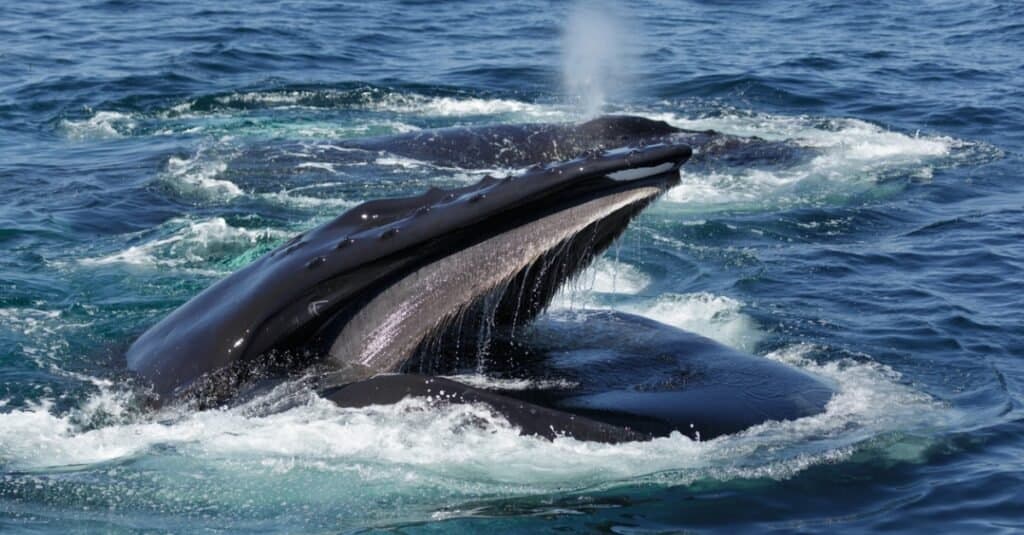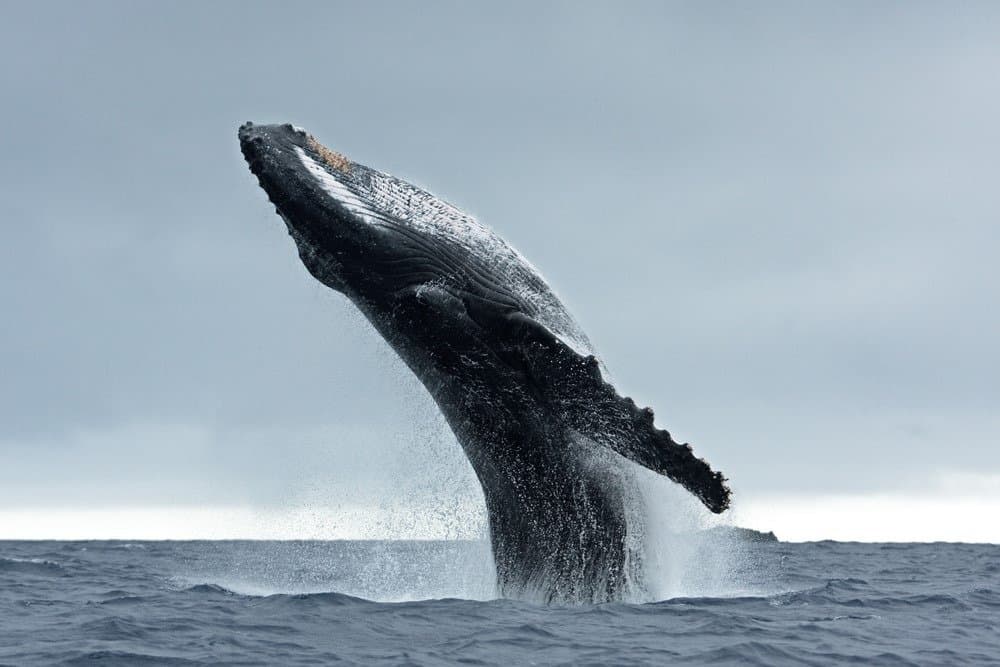Considering how large whales are, you might instinctively have the urge to flee at the sight of one. But not all of these mammalian species are characterized by the presence of teeth. There are two different suborders: the Mysticeti (baleen whales) and the Odontoceti (toothed whales). The difference between these suborders is not limited to these animals’ presence and lack of teeth. Other differences include the presence of blow holes, the species size, and general biology.
In this article, we discuss an animal in one of the suborders – the humpback whale – with a keen focus on its dentition. You’ll find answers to your questions about whether the humpback whale has teeth, if the teeth are indeed sharp, what these teeth are made of, what humpbacks eat, and more. Should you flee at the sight of a humpback whale’s open mouth? Let’s find out.
How To Identify a Humpback Whale
A fully developed humpback has a length of 46-56 ft and weighs 40 tons. It has a knobbly head and long pectoral fins that might be the longest you’d ever see – as they extend to more than one-third the animal’s length. The upper side of this whale is usually black, with the remaining parts of the body having both white and black coloration; as well as their fins. They have smooth skin, and their flippers are what distinguish them from other whales. These whales are breachers, and male humpback whales have a unique characteristic – making music – which makes them a good source of recreation for whale watchers.
Humpback Whales Teeth: Do They Have Them?

Humpback whales have baleen instead of teeth.
©iStock.com/stephenallen75
No, humpback whales do not have teeth. There are many species of toothed whales, but the humpback whale is not one of them. In place of teeth, these whales have baleen – hence are called baleen whales. These baleen whales are characterized by a flexible horny substance hanging from their upper jaw. Baleen are solid but flexible, and humpback whales have up to 270-400 overlapping baleen on each side of their upper jaw. The baleen plates on each side are about 20 inches long.
What Are Humpback Whales Teeth Made Of?

Humpback whales’ baleen are made from keratin.
©Martin Prochazkacz/Shutterstock.com
Humpback whales’ “teeth,” known as baleen, are made from skin-like structures called keratin. Keratin is also a primary component of human hair, skin, and nails. They are usually straw-like and flexible and contain some amount of calcium. In some whales, the baleen extends longer than others and are derived from skin cells. They can be considered firm but not sharp, and are used for filtering and not for biting, chewing, or grinding.
A baleen plate can be about 1.6 ft to 11.5 ft long and weigh up to 200 lb. The hairy fringes around the baleen are called baleen bristle, baleen hair, or whalebone hair. These baleen bristles are arranged in rows on the upper jaw of baleen whales. Also, the higher the calcium salt in the baleen, the stronger it gets. Baleen hairs are mostly calcified in sei whales.
How Do Humpback Whales Feed With Baleen?
Baleen do not merely replace teeth for ‘toothless’ whales, they are a whole filter-feeding system for these whales. While feeding, the first process is for the whale to open its mouth and take in both water and prey, primarily krill and school fish. The whale then closes its mouth and pushes water out through its blowhole and filters small prey animals at the same time. By pressing its tongue against its upper jaw, it forces the water to pass out sideways through the baleen, therefore sieving in its prey. After this, it swallows and retains the nutrients scooped in.
Do Humans Use Humpback Whales Teeth?
In the past, humans used baleen to make baskets, collar stiffeners, buggy whips, backscratchers, parasol ribs, corset stays, crinoline petticoats, switches, and for creasing paper. However, it is no longer in use and has been replaced by synthetic materials such as plastic and fiberglass. The reason for this is not far-fetched. According to the Marine Mammal Protection Act of 1972, it is now illegal in the United States to transport, purchase, sell and even export any marine animal or its products.
What Do Humpback Whales Eat?

Humpback whales are filter feeders, with their primary food being krill and small schooling fish. They also feed on Atlantic mackerel, capelin, herring, sardines, and sand lances. The humpback feeds majorly during the summer and fasts during mating season. Humpback whales’ method of getting their food is called bubbling or bubble-netting. They use this system in groups by coming together and using bubbles to disorient their prey. They can eat up to 3000 lbs of food per day.
Up Next:
Blue Whale Teeth: Do Blue Whales Have Teeth?
Whale Teeth: All About Sperm Whale Teeth, Baleen, and More!
Sperm Whale Teeth: Everything You Need to Know
The photo featured at the top of this post is © Imagine Earth Photography/Shutterstock.com
Sources
- Wikipedia, Available here: https://en.wikipedia.org/wiki/Baleen
- Livescience, Available here: https://www.livescience.com/58464-humpback-whale-facts.html
Thank you for reading! Have some feedback for us? Contact the AZ Animals editorial team.






